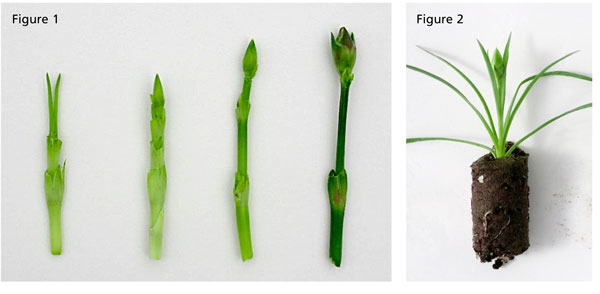4/1/2023
Vegetative Dianthus Culture Tips
Gary Vollmer
Dianthus is truly amazing in its versatility. Overall, greenhouse growers can enjoy a low production cost since it needs very little heat to grow from a cool greenhouse or cold frame outdoors. It can withstand various shipping methods, from racks to produce trucks to mail order. Dianthus as a class has a wide variety of colors, patterns and plant vigors. Plus, it can be scheduled to hit all spring holidays, and sold as both indoor floral or in garden center settings.
At Selecta One, we’ve been watching sales in this category grow massively with hundreds of millions of units sold annually in Europe alone—more than 10 times the numbers on this side of the pond! Now is the time, with new supply chain opportunities in the United States and a new influx of breeding, to get this category growing in North America as well.
To make you even more comfortable producing this plant-of-opportunity, I’ll take you through the basic culture and scheduling of dianthus from an unrooted cutting through the finished product.
Propagation
Dianthus cuttings should ideally be stuck the day of arrival. Cuttings can be stored overnight, if necessary, at 39 to 45F (4 to 7C). Dianthus cuttings, like mums, are stored and healed before shipping. Rehydrating is paramount. Soaking the cuttings in water for three to four hours cut end down can help prevent cuttings from drying out. A rooting hormone is recommended to promote early, uniform rooting. IBA at 1,000 ppm dip is preferred.
 Mist heavily in the first few days to prevent desiccation. Reduce mist after four to five days to prevent excess water in the media. Too wet media will result in heavy callus and slow rooting. Choose a well-drained medium with an EC of 0.75 to 0.80 mmhos and a pH of 5.5 to 5.8. Soil temperature should be maintained at 68 to 72F (20 to 22C) until roots are visible.
Mist heavily in the first few days to prevent desiccation. Reduce mist after four to five days to prevent excess water in the media. Too wet media will result in heavy callus and slow rooting. Choose a well-drained medium with an EC of 0.75 to 0.80 mmhos and a pH of 5.5 to 5.8. Soil temperature should be maintained at 68 to 72F (20 to 22C) until roots are visible.
Begin fertilization when roots become visible with 75 to 100 ppm N. Increase to 150 to 200 ppm N as roots develop. Dianthus rooted cuttings should be ready for transplanting 28 to 33 days after sticking, longer if producing a pinched liner.
Branching
One of the major challenges with many dianthus varieties is pinching. Most varieties benefit from an early pinch. The nature of dianthus growth makes it difficult to pinch; all of the foliage is vertical and the very short internodes are tucked tightly in the center of the plant. It’s much easier to pinch as the flower buds develop and the internodes lengthen (Figure 1). Once the flower bud is formed, the pinch becomes much easier to do (Figure 2).
Research and grower experience has shown that the use of Configure (benzyladenine) at rates from 300 to 600 ppm applied instead of a pinch can replace the pinch and enhance branching.
Finishing
Use media with good aeration and drainage. Maintain soil pH at 5.8 to 6.4. Dianthus should be grown cool or cold depending on the type of production.
Dianthus can be grown year-round, but the most important markets are early spring and spring. Scheduling varies based on genetics and the growing environment (reference the scheduling chart online at selectanorthamerica.com/dianthus).
For cold-season production, grow in as high light conditions as possible. Feed regularly at 200 to 300 ppm N from a complete cal/mag fertilizer. Avoid dramatic swings in media moisture, as root rot can ensue. Based on the varieties and the growing conditions, some may benefit from additional pinching and PGR applications. Dianthus, when grown cool, will need little or no PGRs. When needed, Paclobutrazol sprays at 1 to 2 ppm,
B-Nine at 2,500 ppm, or Cycocel at 500 to 750 ppm are good PGR options.
Pests & Disease
Although rarely a major concern, dianthus are susceptible to thrips, aphid and mites. Diseases like Alternaria and Fusarium are possible, usually occurring during cold wet growing conditions. Preventative treatment programs should be applied as needed.
With these guidelines in hand, plus the helpful tools and grower resources Selecta One has created at our website, your dianthus program will expand and meet a new market demand for such a versatile plant. GT
Gary Vollmer is the global product manager for Selecta One North America and the company’s main technical support expert. Find his plant culture tips and guidelines online at selectanorthamerica.com.